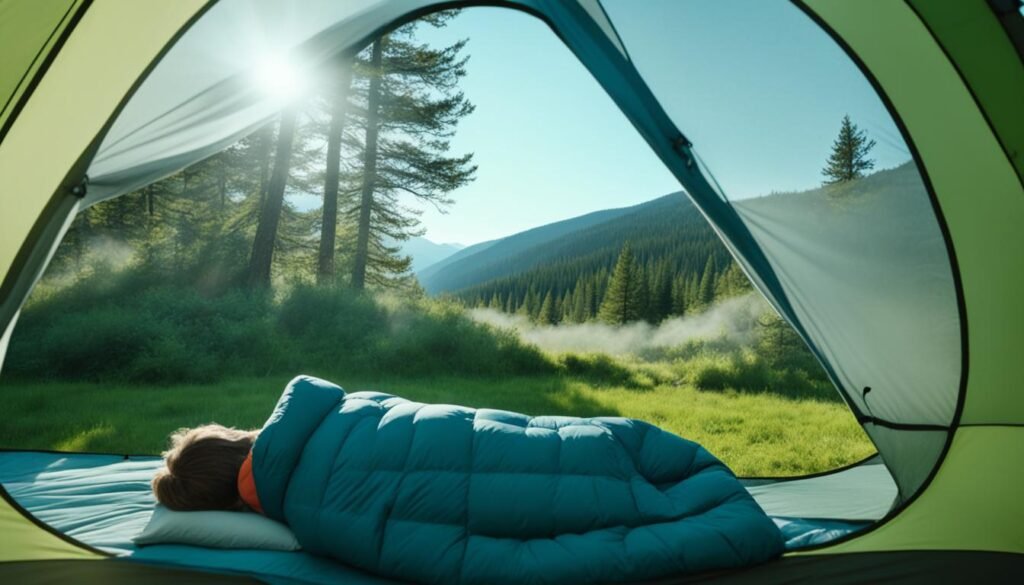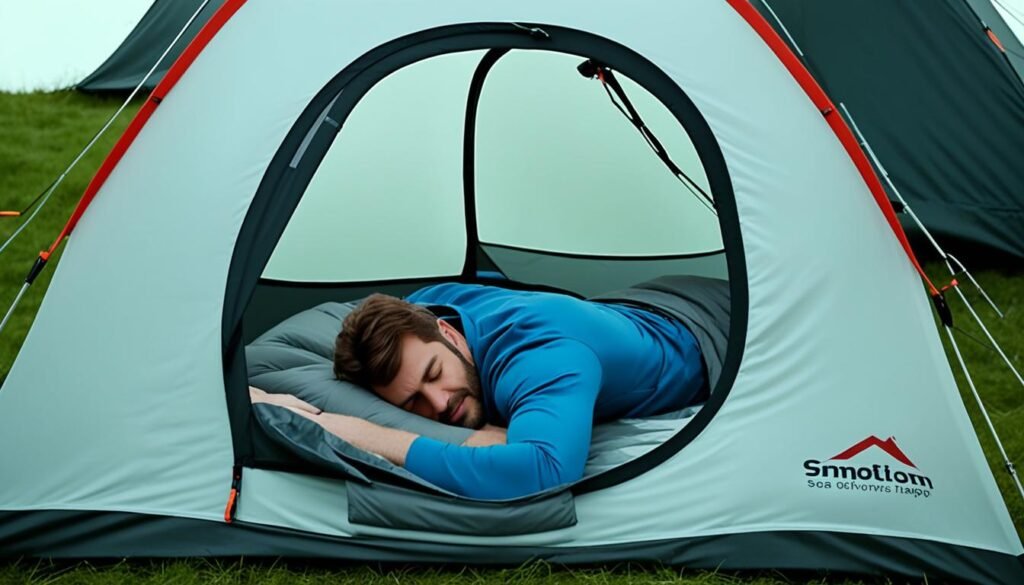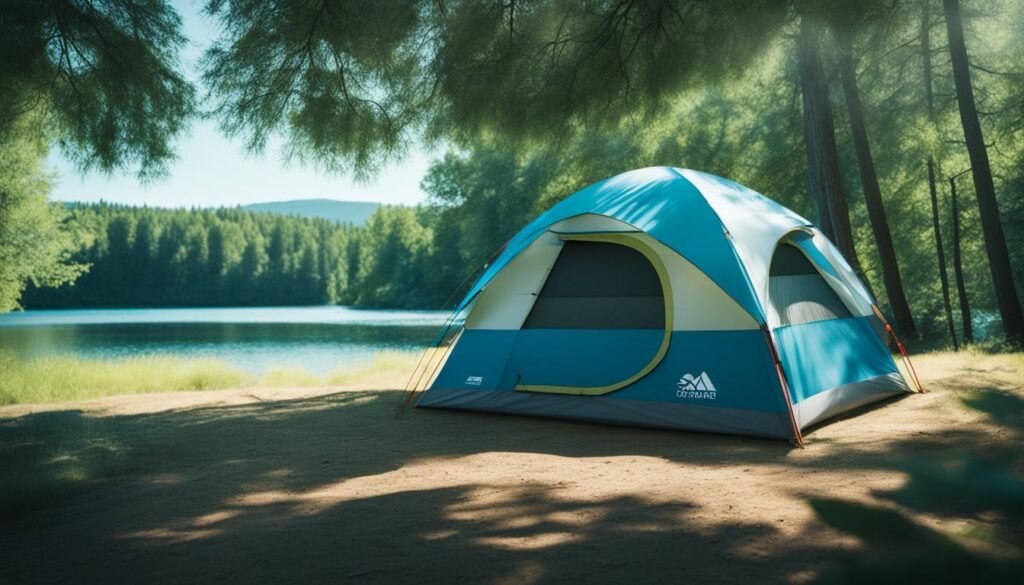Tent condensation can be a camper’s worst enemy, leading to a damp and muggy tent, reduced insulation, and potential health issues. To ensure a comfortable sleep during your camping adventures, proper tent ventilation is crucial. With the right techniques, you can minimize condensation, maximize airflow, and create a pleasant sleeping environment inside your tent.
When it comes to tent ventilation, there are several key factors to consider:
- Pitch your tent in the shade of a tree to keep the temperature lower and reduce condensation.
- Avoid camping near water sources to minimize humidity levels in your tent.
- Choose higher ground to prevent cold air from pooling and to maintain a balanced temperature inside your tent.
- Allow your wet gear to dry outside the tent to prevent excess moisture and humidity.
- Maximize airflow by rolling back the rain fly, opening all vents and windows, and setting up your tent to allow for proper air circulation.
By following these tent ventilation techniques, you can create a comfortable and breathable sleeping environment, ensuring a restful night’s sleep during your camping trips.
Key Takeaways:
- Pitch your tent in the shade to keep the temperature lower and minimize condensation.
- Avoid camping near water sources to reduce humidity levels inside the tent.
- Choose higher ground to prevent cold air from accumulating and maintain a balanced temperature.
- Dry wet gear outside the tent to minimize moisture and humidity.
- Maximize airflow by opening vents and windows, rolling back the rain fly, and setting up your tent for proper air circulation.
The Benefits of Pitching Your Tent in the Shade
Pitching your tent in the shade of a sturdy tree offers numerous advantages for tent ventilation and overall camping comfort. When you camp under the refreshing canopy of trees, you can experience a more pleasant and enjoyable camping experience. Let’s explore the benefits of shade tent camping and why it’s an excellent choice for your next outdoor adventure.
Regulating Temperature
One of the significant benefits of pitching your tent in the shade is the temperature regulation it provides. The cool cover of trees helps to lower the temperature inside your tent, preventing it from turning into a hot and stuffy environment. By reducing the temperature differential between the inside and outside of your tent, you can minimize the risk of condensation and ensure a more comfortable sleep.
Minimizing Condensation
Camping under trees helps divert condensation away from your tent. When moisture evaporates from the ground, it can accumulate on the leaves instead of settling on your tent surface. This natural occurrence reduces the likelihood of waking up to a damp and muggy tent in the morning. By choosing shade tent camping, you prioritize a dryer and more comfortable camping experience.
Choosing the Right Tree
While pitching your tent in the shade has its advantages, it is crucial to choose a sturdy and suitable tree. Look for a tree with strong branches and a healthy appearance to avoid the risk of falling branches. Additionally, be mindful of any potential hazards such as dead or diseased trees. Prioritizing safety ensures a worry-free camping experience.
Additional Considerations
Keep in mind that even while camping in the shade, it is still important to follow other tent ventilation tips. Maximizing air circulation by utilizing vents and windows, positioning your tent to allow airflow, and properly maintaining your tent are all essential for reducing condensation and promoting a comfortable sleep. Remember to set up your tent in a way that allows airflow from the direction of the wind for optimal ventilation.
“Camping under the shade of trees not only offers respite from the sun but also provides natural insulation and a cooler environment inside the tent. It’s the perfect way to harmonize with nature while enjoying a comfortable camping experience.” – experienced camper
By choosing to pitch your tent in the shade, you can enhance your camping experience by reducing condensation and regulating temperature. The refreshing cover of trees not only provides a cooler environment inside your tent but also adds natural beauty to your campsite. So, next time you go camping, consider the benefits of shade tent camping and enjoy a restful and relaxing adventure amidst nature’s serene embrace.
The Importance of Camping Away from Water Sources
When planning your camping trip, it’s important to consider the location of your campsite in relation to water sources. While the idea of camping beside a serene lake or flowing river can be enticing, it’s crucial to understand the impact it can have on your camping experience. Camping near water sources can increase humidity levels and the potential for condensation inside your tent, leading to a damp and uncomfortable sleep.
Reducing tent humidity is key to ensuring a pleasant camping experience. By camping further back from water sources, you can minimize humidity levels and significantly reduce the chances of condensation forming inside your tent.
Benefits of Camping Away from Water
Camping away from water sources offers several advantages:
- Lower humidity: By positioning your tent away from water, you can reduce the overall humidity inside the tent. This helps to prevent condensation and keeps your sleeping area dry and comfortable.
- Improved ventilation: Setting up camp away from the water allows for better airflow around your tent. With better air circulation, you can maintain a more comfortable temperature and reduce the risk of condensation.
- Reduced insect activity: Water sources often attract insects like mosquitoes and bugs. By camping away from water, you can minimize the presence of these pests and enjoy a more peaceful sleep.
Remember, choosing the right campsite location is essential for a comfortable and enjoyable camping experience. By camping away from water sources, you can minimize humidity levels, reduce the chances of condensation forming inside your tent, and create a more comfortable sleeping environment.
The Benefits of Camping on Higher Ground
When it comes to choosing a camping spot, the elevation of your campsite can have a significant impact on your camping experience. Camping on higher ground offers several benefits, including preventing condensation in tents and improving overall comfort.
By selecting a campsite on slightly higher ground, you can avoid the issue of cold air pooling in dips or low-lying areas. Cold air tends to sink, and when it accumulates around your tent, it can create a temperature differential between the inside and outside. This temperature difference is a major contributor to condensation formation. However, by camping on higher ground, you can minimize this effect and maintain a more balanced temperature inside your tent.
In addition to preventing condensation, camping on higher ground also offers improved airflow. When you set up your tent at an elevated position, it allows for better air circulation, especially if there is a breeze. This increased airflow helps to reduce the humidity levels inside the tent, further reducing the risk of condensation.
Moreover, camping on higher ground can also provide better drainage in case of rain. The chances of water pooling around your tent are lower, as the natural slope of the ground allows water to run off more effectively, keeping the inside of your tent dry.
By taking advantage of the benefits of camping on higher ground, you can enhance your camping experience and ensure a comfortable and enjoyable stay. Just remember to find a spot that is not too steep or exposed to strong winds, as these factors can affect the stability and safety of your tent.
Choose to camp on higher ground to prevent condensation, improve airflow, and create a more comfortable camping environment. With the right campsite selection, you can elevate your camping experience to new heights.
Drying Wet Gear Outside the Tent
To prevent excess humidity inside the tent, it is recommended to dry wet gear outside the tent. Bringing damp clothes inside the tent will increase humidity levels and potentially lead to condensation. Hang wet clothes under a tarp or use a clothesline outside the tent to dry them.
Drying your gear outside the tent not only helps to reduce moisture buildup but also keeps your sleeping area dry and comfortable. By following these camping gear drying tips, you can ensure that your tent remains dry and condensation-free:
- Choose a shady location with good airflow to hang your wet gear.
- Use a clothesline or cords to hang clothes, towels, and other wet items.
- Spread out wet gear, such as rain jackets or pants, on rocks or branches to maximize drying.
- If possible, hang a tarp or rainfly above the drying area to protect your belongings from rain or direct sunlight.
- Keep an eye on the weather forecast and plan ahead to take advantage of sunny and windy days.
By implementing these tent condensation prevention strategies and camping gear drying tips, you can maintain a dry and comfortable camping experience. Remember to always prioritize proper ventilation and airflow to minimize condensation formation inside your tent.
Proper Maintenance and Drying of Your Tent
After camping in the rain, it is crucial to take proper care of your tent to ensure its longevity and optimal performance. Drying your tent thoroughly before packing it up is an essential step in tent maintenance.
If time allows, the most effective way to dry your tent is by exposing it to sunlight. Find a well-ventilated area, preferably with a gentle breeze, and set up your tent in a way that maximizes exposure to sunlight. This will help evaporate any moisture trapped in the fabric.
If you are short on time or the sun is not available, you can still remove excess moisture by using a clean towel. Gently wipe down the interior and exterior of the tent, paying extra attention to areas that tend to accumulate moisture, such as seams and corners.
To prevent moisture transfer and potential damage, it is recommended to separate the rainfly from the inner tent. Pack them separately in stuff sacks or plastic bags to avoid any moisture transferring from the rainfly to the inner tent.
Proper storage is also crucial for maintaining the quality of your tent. Once it is completely dry, fold it carefully, avoiding excessive creasing. Store your tent in a cool, dry place, away from direct sunlight and extreme temperatures.
Following these tent maintenance tips will not only prolong the lifespan of your tent but also ensure that it remains in excellent condition for your next camping adventure.
Tent Drying Methods:
- Expose your tent to sunlight for natural drying.
- Use a clean towel to wipe down excess moisture.
- Separate the rainfly from the inner tent for better storage.
- Store your tent in a cool, dry place.
Maximizing Air Circulation in Your Tent
Proper air circulation is crucial for reducing condensation in your tent. When it comes to improving tent airflow and maximizing tent ventilation, there are a few key strategies to keep in mind.
Pitch Your Tent Correctly
If you have a double-walled tent, ensure that it is pitched correctly to allow maximum air circulation between the rainfly and the inner wall. This creates a gap that promotes airflow and helps prevent condensation from building up.
To achieve this, follow the manufacturer’s instructions carefully and ensure that the rainfly is properly tensioned. A tightly pitched rainfly can restrict airflow and contribute to condensation, so find the right balance to optimize ventilation.
Roll Back the Rainfly and Vestibule Door
To improve tent airflow, consider rolling back the rainfly and vestibule door when weather conditions allow. This allows fresh air to enter the tent, promoting better ventilation and reducing the chances of condensation. However, make sure to monitor the weather forecast and roll the rainfly back in the event of rain or strong winds to protect your gear.
Open Every Vent and Window
Take advantage of all available ventilation options by opening every vent and window in your tent. This creates cross ventilation, allowing air to circulate more effectively and minimizing the risk of condensation. Be sure to secure the openings with mesh or bug netting to keep insects out while still allowing air to flow.
Position Your Tent for Breeze Entry
Set up your tent in a way that allows the breeze to enter freely. Position the door facing the direction of the wind to encourage airflow throughout the tent. If there is no natural breeze, you can create airflow by using a battery-operated fan or opening a car window strategically if camping near your vehicle.
| Air Circulation Tips | |
|---|---|
| 1 | Roll back the rainfly and vestibule door when weather permits |
| 2 | Open every vent and window for cross ventilation |
| 3 | Position your tent to face the direction of the wind |
| 4 | Consider using a battery-operated fan for additional airflow |
By implementing these strategies, you can enhance tent air circulation, improve tent airflow, and maximize tent ventilation. This helps create a more comfortable and condensation-free environment inside your tent, allowing you to enjoy your camping experience to the fullest.

Innovative Solutions for Managing Tent Condensation
Some tent designs offer innovative solutions for managing condensation. One such example is the Tension Ridge feature found in the Telos and Alto tents. This design enhancement enhances venting and adapts to your needs, allowing for better control of airflow within the tent.
The Apex vents positioned at the highest point of the tent play a crucial role in effective condensation management. These strategically placed vents allow hot air to escape efficiently, reducing the likelihood of condensation buildup. This not only helps to regulate the temperature inside the tent but also improves overall ventilation.
In addition to the Tension Ridge and Apex vents, innovative tent designs often feature larger doors that improve airflow. These larger openings make it easier to enter and exit the tent while facilitating better air circulation.
Another important aspect of advanced tent ventilation is the incorporation of vertical walls in the design. These vertical walls provide more breathing room and minimize the risk of accidentally touching the inner fabric, which can lead to getting wet from condensation.
| Tent Design | Key Features |
|---|---|
| Telos Tent | Tension Ridge for enhanced venting Apex vents for effective heat dissipation Larger doors for improved airflow |
| Alto Tent | Tension Ridge for adaptable venting Apex vents for efficient condensation management Vertical walls for improved breathing room |
These innovative tent designs offer advanced ventilation solutions that effectively manage condensation, ensuring a more comfortable camping experience. By incorporating features like Tension Ridge, Apex vents, and larger doors, these tents prioritize airflow and create a healthier and more enjoyable environment inside the tent.
Additional Tips for Ventilating Your Tent
When it comes to tent ventilation strategies, there are a few additional tips that can help you maximize airflow and find effective tent condensation solutions. By following these tips, you can ensure a comfortable and well-ventilated sleep environment in your tent.
Orienting Your Tent
To maximize tent airflow, it’s important to consider the orientation of your tent. When camping in wet conditions, orient the foot of the tent towards the wind and open the Baseline Vent. This will increase airflow without letting in rain. On the other hand, in hot and humid conditions, orient the head of the tent towards the wind and open the Apex Vent. This setup allows the tent to scoop up fresh air and lets the natural pressure force it down and out through the Baseline vents.
Interior Ventilation Control
Another helpful feature to look for in a tent is the ability to open and close vents from inside the tent. This allows for convenient airflow control, especially during sudden onset torrential rain when you need to quickly close the vents to prevent water ingress.
To put it simply, by strategically orienting your tent, opening the appropriate vents, and controlling ventilation from inside, you can effectively maximize tent airflow and minimize the risk of condensation.
The Importance of Choosing the Right Tent
When it comes to camping, selecting the right tent is crucial for a comfortable outdoor experience. A well-ventilated tent not only keeps you cool during warm nights but also prevents condensation and ensures a good night’s sleep. Here are some essential factors to consider when choosing the perfect tent for your camping trip.
1. Lightweight Materials: Look for tents made with lightweight materials such as nylon, polyester, and mesh panels. These materials offer breathability, allowing fresh air to circulate inside the tent and minimizing the chances of condensation.
2. Windows, Vents, and Adjustable Rainfly: Opt for a tent that features multiple windows, vents, and an adjustable rainfly. Windows and vents promote airflow, while an adjustable rainfly allows you to control ventilation according to the weather conditions.
3. Size and Airflow: Consider the size of the tent and ensure it provides enough space for adequate airflow. A snug fit may restrict ventilation, leading to a stuffy and uncomfortable sleeping environment.
4. Second-hand Tents and Sales: If you are on a budget, consider buying tents from second-hand sources or taking advantage of camping gear sales. This way, you can find well-ventilated tents at a lower cost.
Choosing a well-ventilated tent is essential for a comfortable camping experience. The right tent will keep you cool, prevent condensation, and ensure a restful sleep. Take the time to consider the materials, ventilation features, size, and cost-saving options when selecting your camping companion.
Top Tents for Ventilation
| Tent Brand | Materials | Ventilation Features | Price |
|---|---|---|---|
| Brand A | Nylon | Multiple windows, vents, adjustable rainfly | $200 |
| Brand B | Polyester | Mesh panels, built-in vents, adjustable rainfly | $250 |
| Brand C | Nylon | Large windows, high peak vents | $180 |
Creating a Comfortable Sleeping Environment
In warmer temperatures, it is important to make adjustments to ensure a comfortable sleep while camping. The heat and humidity inside a tent can make it challenging to get a good night’s rest. Here are some tips to help you stay cool and comfortable:
- Add a Barrier: Placing a barrier, such as a tarp or camping mat, between the tent floor and the ground can help insulate against heat and moisture. This additional layer can provide some much-needed comfort for a better sleep experience.
- Seek Shade: Position your tent in the shade to reduce direct sunlight and heat. If shade is limited, consider creating shade using a tarp or canopy. This can significantly lower the temperature inside the tent and make it more comfortable for sleeping.
- Maximize Ventilation: Open the window and door flaps of your tent to promote air circulation. Removing the rainfly, if weather permits, can also enhance ventilation and help cool down the interior. If available, using a small fan or portable air conditioner can further improve air circulation and create a cooler sleeping environment.
- Choose the Right Sleeping Gear: Opt for a comfortable sleeping pad or cot that allows air to flow underneath. This can help prevent heat from building up beneath you. Additionally, using a lightweight sleeping bag or just a cover instead of a heavy sleeping bag can ensure better air circulation and temperature regulation.
By implementing these tips, you can optimize your sleeping environment, stay cool while camping, and enjoy a restful night’s sleep, even in a hot tent.
Regulating Body Temperature and Hydration
Regulating your body temperature is crucial for a comfortable sleep while camping. It’s important to prioritize camping sleep hygiene, temperature regulation for camping, and hydration tips for camping to ensure a restful night’s sleep. Here are some key strategies to consider:
- Stay hydrated: Drinking an adequate amount of water throughout the day is essential for maintaining proper hydration levels. Dehydration can lead to discomfort and impaired body temperature regulation. Remember to bring a sufficient supply of clean drinking water and drink regularly.
- Cooling techniques: One effective way to cool off during hot nights is by wetting a bandana with cold water and placing it on your neck, chest, or head. This can provide immediate relief and help regulate body temperature.
- Moisture-wicking fabrics: When choosing sleepwear, opt for fabrics like cotton, silk, or modal that have moisture-wicking properties. These fabrics draw moisture away from the body, keeping you cool and dry throughout the night.
- Avoid alcohol: While a nightcap may seem tempting, consuming alcohol before bedtime can disrupt sleep patterns and interfere with temperature regulation. It’s best to avoid alcoholic beverages close to bedtime.
- Engage in physical activities: Participating in physical activities during the day can help align your body’s internal clock with the natural light pattern. This alignment aids in falling asleep and waking up earlier, promoting a healthier sleep-wake cycle.
By implementing these strategies, you can optimize your camping sleep experience and ensure that your body stays comfortable and well-regulated throughout the night.
The Importance of Good Sleep Hygiene
Maintaining good sleep hygiene while camping is crucial for ensuring a restful and rejuvenating sleep experience. By following a few simple practices, you can improve sleep quality and wake up feeling refreshed and energized.
Establish a Consistent Sleep Schedule
One of the key elements of good sleep hygiene is maintaining a consistent sleep schedule. Try to align your body’s internal clock with the natural sunlight pattern by going to bed and waking up at the same time every day. This helps regulate your sleep-wake cycle and promotes better sleep quality.
Avoid Alcohol before Bedtime
While camping, it may be tempting to relax and unwind with a drink at the end of the day. However, consuming alcohol before bedtime can disrupt your sleep patterns and lead to poorer sleep quality. It’s best to avoid alcohol or limit your intake in the hours leading up to bedtime.
Engage in Relaxing Activities
Before turning in for the night, engage in relaxing activities that help wind down your mind and body. Reading a book, practicing meditation, or listening to calming music can promote a sense of relaxation and prepare you for a peaceful sleep in the great outdoors.
Choose Comfortable Sleepwear and Lightweight Bedding
The right sleepwear and bedding can make a significant difference in your sleep quality while camping. Opt for sleepwear made from moisture-wicking fabrics that help keep you dry and comfortable throughout the night. Additionally, have a lightweight cover or sleep sack available to adjust to changes in temperature and ensure optimal comfort.
Camping provides an opportunity to experience sleep routine in nature, surrounded by the soothing sounds and tranquility of the great outdoors. Maintaining good sleep hygiene can enhance this experience and result in a deep and refreshing slumber.
The Benefits of Outdoor Activities for Sleep
Engaging in physical activities during camping trips, such as swimming, hiking, or biking, can contribute to better sleep. Exposure to natural light and being in nature can help regulate your body’s internal clock and promote earlier sleep onset. Taking advantage of the natural environment by waking up early to enjoy sunrise can also help establish a consistent sleep routine while camping.
Physical activities while camping not only provide an opportunity to explore the surroundings and keep fit but also have a positive impact on sleep quality. When you engage in activities that require physical exertion, your body gets tired, making it easier to fall asleep and stay asleep throughout the night.
When you spend time outdoors, your body is exposed to natural sunlight, which helps regulate your body’s internal clock and improves melatonin production. This hormone is essential for maintaining a healthy sleep-wake cycle.
The exposure to natural light while camping, especially in the morning, helps reset your circadian rhythm, making it easier to fall asleep at night and wake up feeling refreshed in the morning. This natural light exposure can help regulate your sleep patterns and ensure a more restful sleep.
Furthermore, being in nature has a calming and relaxing effect on the mind and body, reducing stress and anxiety that can hinder sleep. The peaceful surroundings, fresh air, and soothing sounds of nature can create a serene environment, making it easier to unwind and drift off to sleep.
So, make sure to incorporate physical activities into your camping trips, enjoy the natural light, and embrace the calming effects of nature to improve your sleep quality.
Sleep-Enhancing Physical Activities
Here are a few physical activities you can engage in during your camping trips to promote better sleep:
- Hiking in the scenic trails
- Swimming in a nearby lake or river
- Biking through the campsite or surrounding areas
- Yoga or stretching exercises outdoors
- Playing outdoor games like frisbee or volleyball
Taking Advantage of the Natural Environment
Waking up early to witness the sunrise can be a rejuvenating experience that helps establish a consistent sleep routine. The soft golden hues and tranquil ambiance of the early morning can set a peaceful tone for the day and create a sense of calmness.

Appreciating the beauty of nature and waking up with the sun can help regulate your sleep patterns and enhance your camping sleep experience.
Conclusion
Ventilating your tent properly is essential for a comfortable sleep while camping. By following the tips mentioned in this article, you can minimize condensation, maximize airflow, and create an optimal sleeping environment in your tent. Choosing the right tent, considering the location and conditions of your campsite, and regulating your body temperature are all key factors in ensuring a restful and enjoyable camping experience.
Remember to prioritize good sleep hygiene by establishing a consistent sleep schedule, avoiding alcohol before bedtime, and engaging in relaxing activities to help wind down. Additionally, take advantage of outdoor activities such as swimming, hiking, or biking, as they can contribute to better sleep by exposing you to natural light and regulating your body’s internal clock.
Whether you’re a seasoned camper or new to the camping experience, these strategies will help you make the most of your camping sleep. By creating a well-ventilated and comfortable sleeping environment, you can wake up refreshed and ready to enjoy all the wonders of the great outdoors. Happy camping!
FAQ
How can I improve airflow and ventilate my tent for a comfortable sleep?
To improve airflow and ventilate your tent, you can pitch your tent in the shade of a tree, camp away from water sources, choose higher ground, dry wet gear outside the tent, and maximize air circulation by rolling back the rain fly, opening all vents and windows, and setting up your tent to allow airflow from the direction of the wind.
What are the benefits of pitching my tent in the shade?
Pitching your tent in the shade of a sturdy tree can help reduce condensation by keeping the temperature lower and allowing condensation to gather on the leaves instead of on your tent. However, it is important to choose a tree that does not pose the risk of falling branches.
Why is it important to camp away from water sources?
Camping away from water sources can reduce humidity levels and minimize the chances of condensation forming inside your tent. By camping further back from nearby water sources, you can decrease the potential for increased humidity and moisture inside your tent.
What are the benefits of camping on higher ground?
Camping on slightly higher ground prevents cold air from pooling in dips in the landscape, helping to maintain a balance between the temperatures inside and outside your tent. This can reduce the likelihood of condensation forming inside your tent.
How can I dry wet gear outside the tent?
To prevent excess humidity inside the tent, it is recommended to dry wet gear outside the tent. Hang wet clothes under a tarp or use a clothesline outside the tent to dry them. Avoid bringing damp clothes inside the tent, as it can increase humidity levels and lead to condensation.
What is the proper way to maintain and dry a wet tent?
After camping in the rain, it is important to dry your tent before packing it up. Wipe it down with a towel to remove excess moisture, or dry it in the sun if possible. Separate the rainfly from the inner tent and pack them separately in stuff sacks to prevent moisture transfer. Proper maintenance and drying of your tent will help prevent condensation and prolong its lifespan.
How can I maximize air circulation in my tent?
To maximize air circulation in your tent, make sure a double-walled tent is pitched correctly to allow maximum airflow between the rainfly and the inner wall. Roll back the rainfly and vestibule door, open all vents and windows, and set up your tent in a way that allows airflow from the direction of the wind. This will help facilitate air circulation and dehumidify your tent.
Are there any innovative solutions for managing tent condensation?
Some tent designs offer innovative solutions for managing condensation. For example, tents like the Telos and Alto feature a Tension Ridge that enhances venting and adapts to your needs. Apex vents positioned at the highest point of the tent allow hot air to escape effectively, and larger doors improve airflow. These designs also have vertical walls that provide more breathing room and reduce the risk of touching the inner fabric, minimizing the likelihood of getting wet from condensation.
What are some additional tips for ventilating a tent?
In addition to the mentioned techniques, you can consider orienting the foot or head of your tent towards the wind, depending on the weather conditions, and open the Baseline Vent or Apex Vent accordingly. This will help increase airflow while still providing protection from rain. Also, purchasing a tent made with breathable materials, having multiple windows and vents, or using a small fan or portable air conditioner can all aid in maximizing tent ventilation.
How important is it to choose the right tent for ventilation?
Choosing the right tent is crucial for proper ventilation. Look for lightweight materials like nylon, polyester, and mesh panels that offer breathability. Opt for a tent with multiple windows, vents, and an adjustable rainfly to ensure good ventilation. Consider the size of the tent as well, as a snug fit may restrict airflow. Choosing a well-ventilated tent is essential for a comfortable and condensation-free camping experience.
How can I create a comfortable sleeping environment in a hot tent?
To create a comfortable sleeping environment in a hot tent, you can add a barrier between the tent floor and the ground to protect against heat and moisture. Placing your tent in the shade or creating shade with a tarp shelter can help reduce direct sunlight. Opening window and door flaps, removing the rainfly for maximum ventilation, using a small fan or portable air conditioner, and opting for lightweight sleep gear can all contribute to a cooler and more comfortable sleep.
How can I regulate my body temperature and stay hydrated while camping?
Regulating your body temperature and staying hydrated are important for a comfortable sleep while camping. Stay hydrated by drinking plenty of water and consider wetting a bandana with cold water to cool off by placing it on your neck, chest, or head. Use moisture-wicking fabrics like cotton, silk, or modal for loose pajamas to stay cool and dry. Avoid consuming alcohol before bedtime, as it can disrupt sleep quality.
Why is good sleep hygiene important while camping?
Maintaining good sleep hygiene while camping is important for your overall sleep quality. By establishing a consistent sleep schedule, avoiding alcohol before bedtime, and engaging in relaxing activities, you can improve your sleep quality. Choosing comfortable sleepwear and having a lightweight cover nearby can also contribute to a better night’s sleep.
What are the benefits of outdoor activities for sleep while camping?
Engaging in physical activities during camping trips, such as swimming, hiking, or biking, can contribute to better sleep. Exposure to natural light and being in nature can help regulate your body’s internal clock and promote earlier sleep onset. Taking advantage of the natural environment by waking up early to enjoy the sunrise can help establish a consistent sleep routine while camping.







